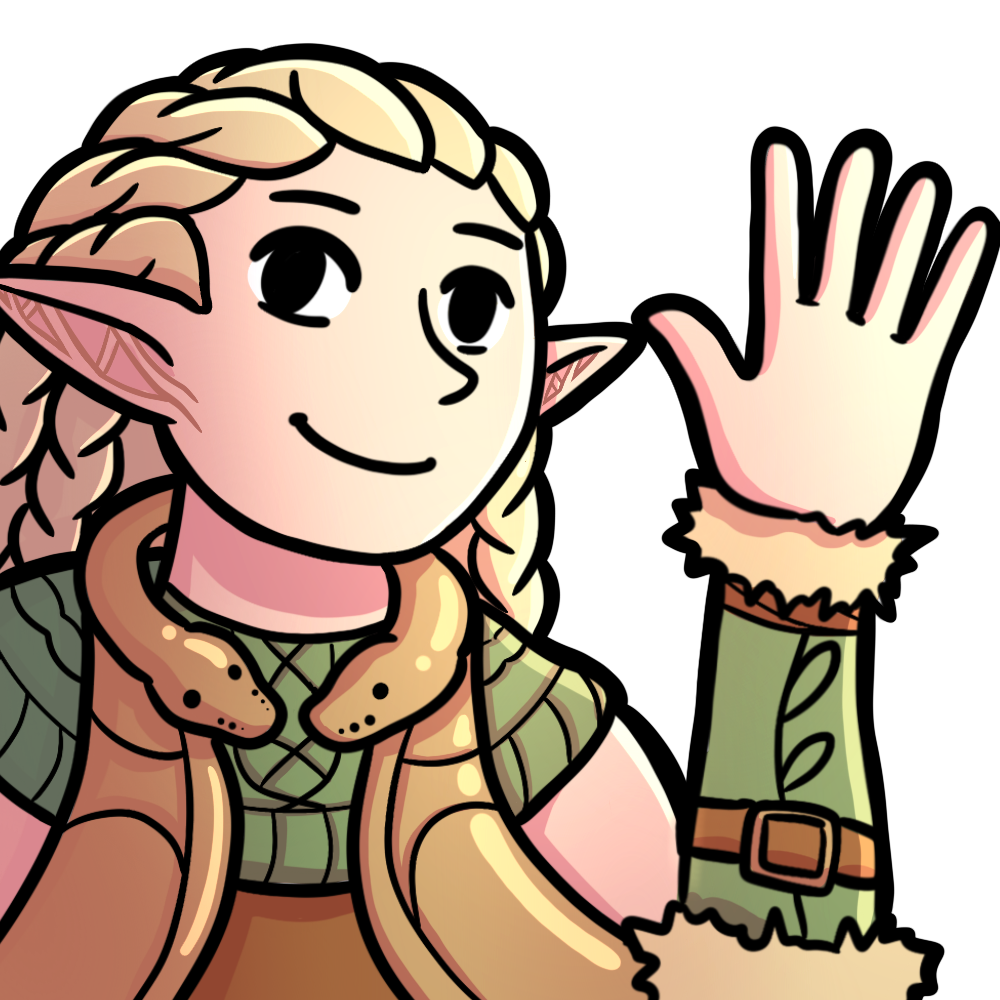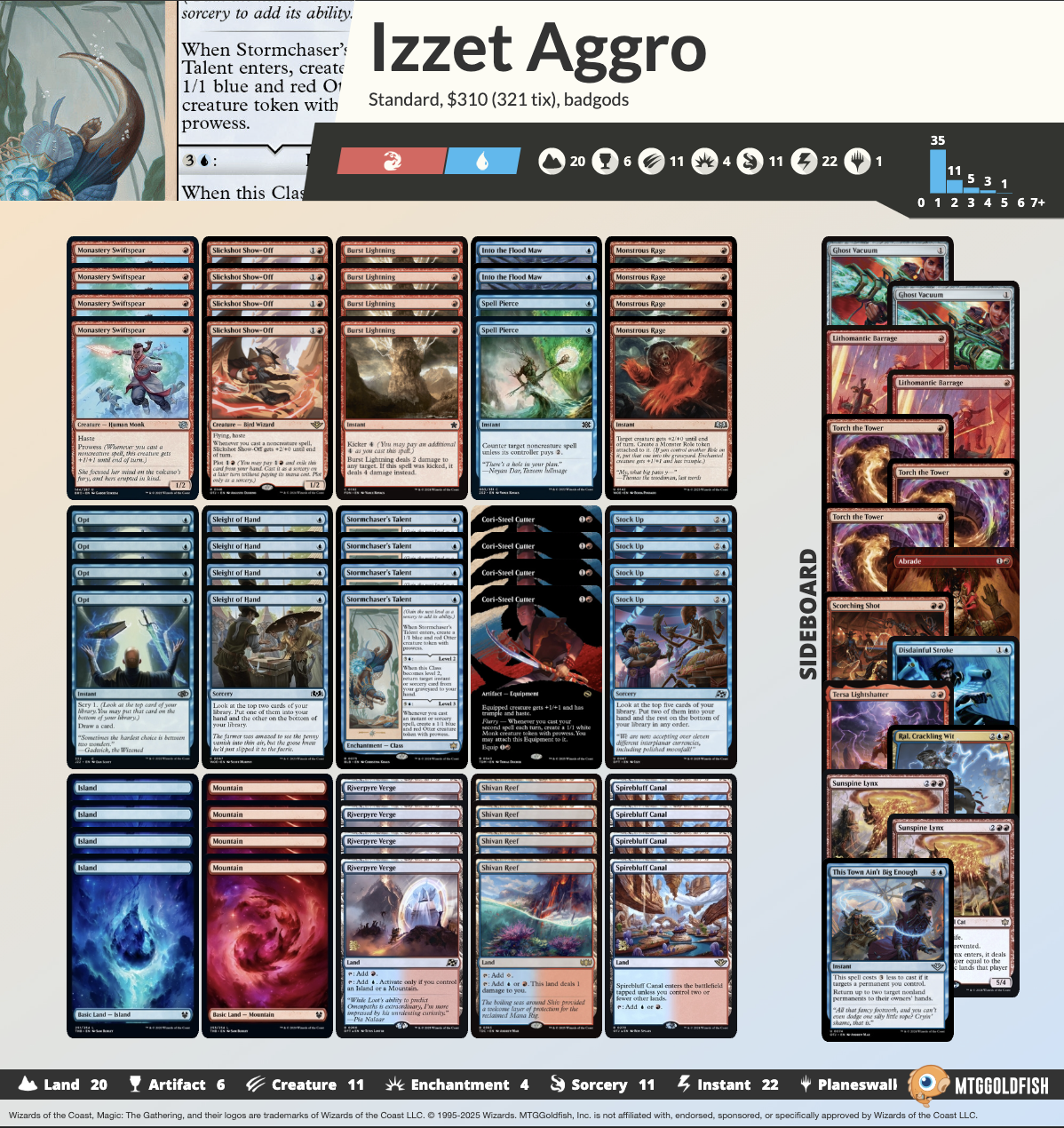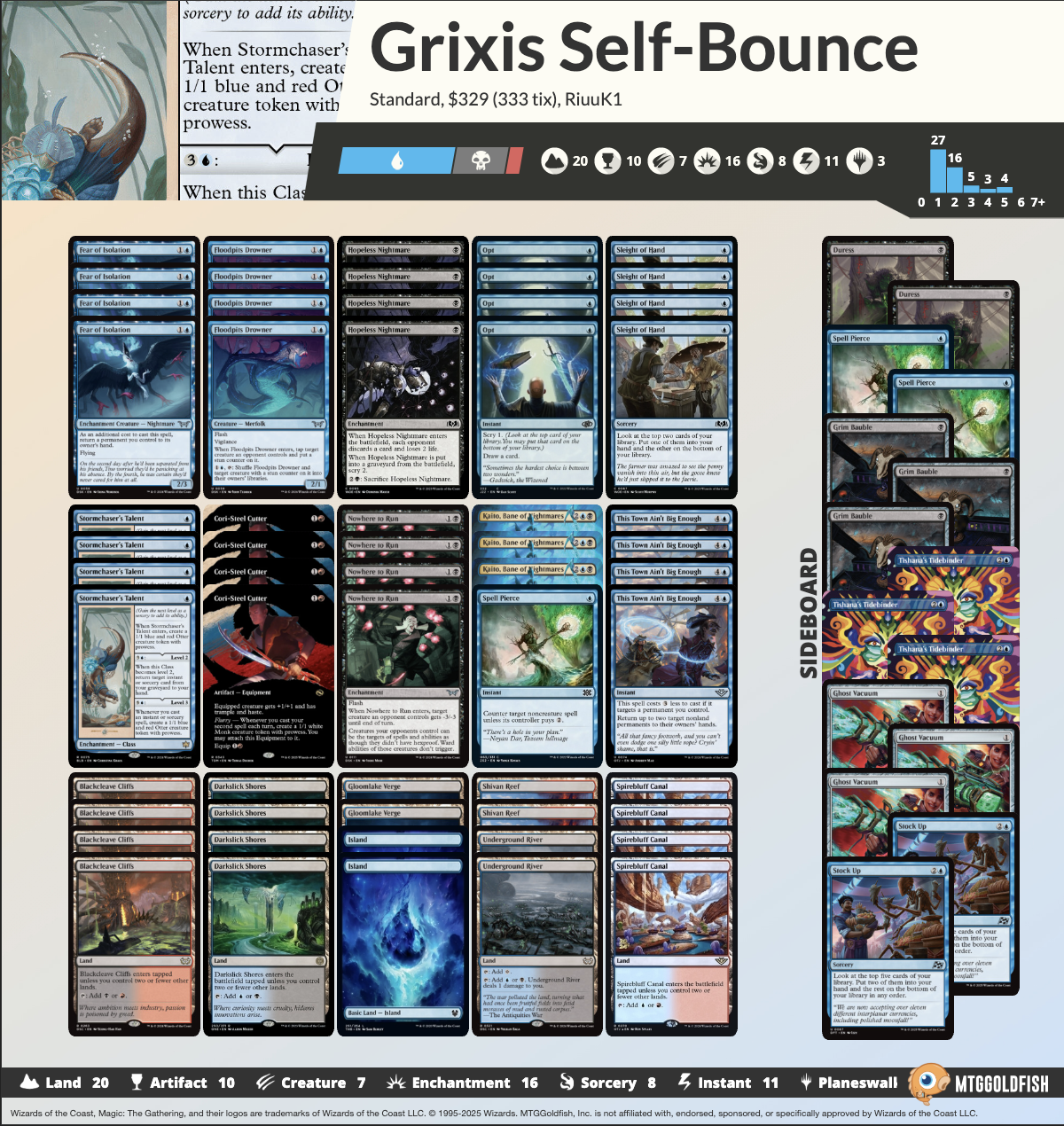Otters with Knives!
04/27/2025
Cori-Steel Cutter is undeniably the most influential card from TDM. It has risen in popularity in both Standard and Modern, powering Izzet Prowess decks in both formats. Its ability to provide a continual stream of hasty 2/2 prowess Monk tokens for just 2 mana makes it an incredible aggressive card, allowing for fast kills while also shoring up your lategame.
That said, while prowess aggro is the natural home of Cutter, the card is powerful enough to see play in other shells. For instance, some people have been trying to put it into Dimir Bounce in Standard, with the idea that bounce effects let you double-spell quite often, and aggressive cards are nice with
Hopeless Nightmare.I wouldn't say that I particularly endorse this specific direction, as I don't think Cutter solves the main issue that Dimir Bounce faces (not being able to play
Nurturing Pixie), while removing one of its advantages (good mana). But the fact that this deck exists shows the broad power of Cutter as a card.Of course, when I first saw the card Cori-Steel Cutter, one of my first thoughts was, predictably, that it's a card that's castable with Temur mana - and therefore, one that could maybe go into my beloved Otters deck!
Otters has always been a somewhat controversial deck. I have pretty consistently held a high opinion of the deck, but we on Sanctum objectively didn't do particularly well with it in its debut at Worlds. cftsoc top 8'd Spotlight Series Atlanta with the deck, but they did so while being quite skeptical the whole time - one of their worries has forever been that the deck is much less powerful when it doesn't draw the card
Enduring VitalityThe deck also fell by the wayside a little bit as the meta shifted to decks that were efficient and aggressive while still having plenty of lategame grinding potential - namely, Gruul Mice and Esper Pixie. I certainly tried to make Otters work for PT DFT, but could not find a build that I could justify registering into the expected metagame.
But now, we might be back. After rebuilding the deck to incorporate Cutter, and playing with it a ton both on ladder and in focus testing, I now once again believe it to be a strong potential choice. I wouldn't call it "busted" - it still has a few awkwardnesses to work out - but it is certainly the deck I will be registering for RC Minneapolis next weekend.
So, today, let's talk about Otters. I'll go over how Cutter has changed and improved the deck, and the new play patterns it introduces. I'll give a brief matchup and sideboard guide for all of the currently popular decks in Standard - though I might release a small update later as I continue to work on the deck. I would recommend reading my previous article
Part 0: The List
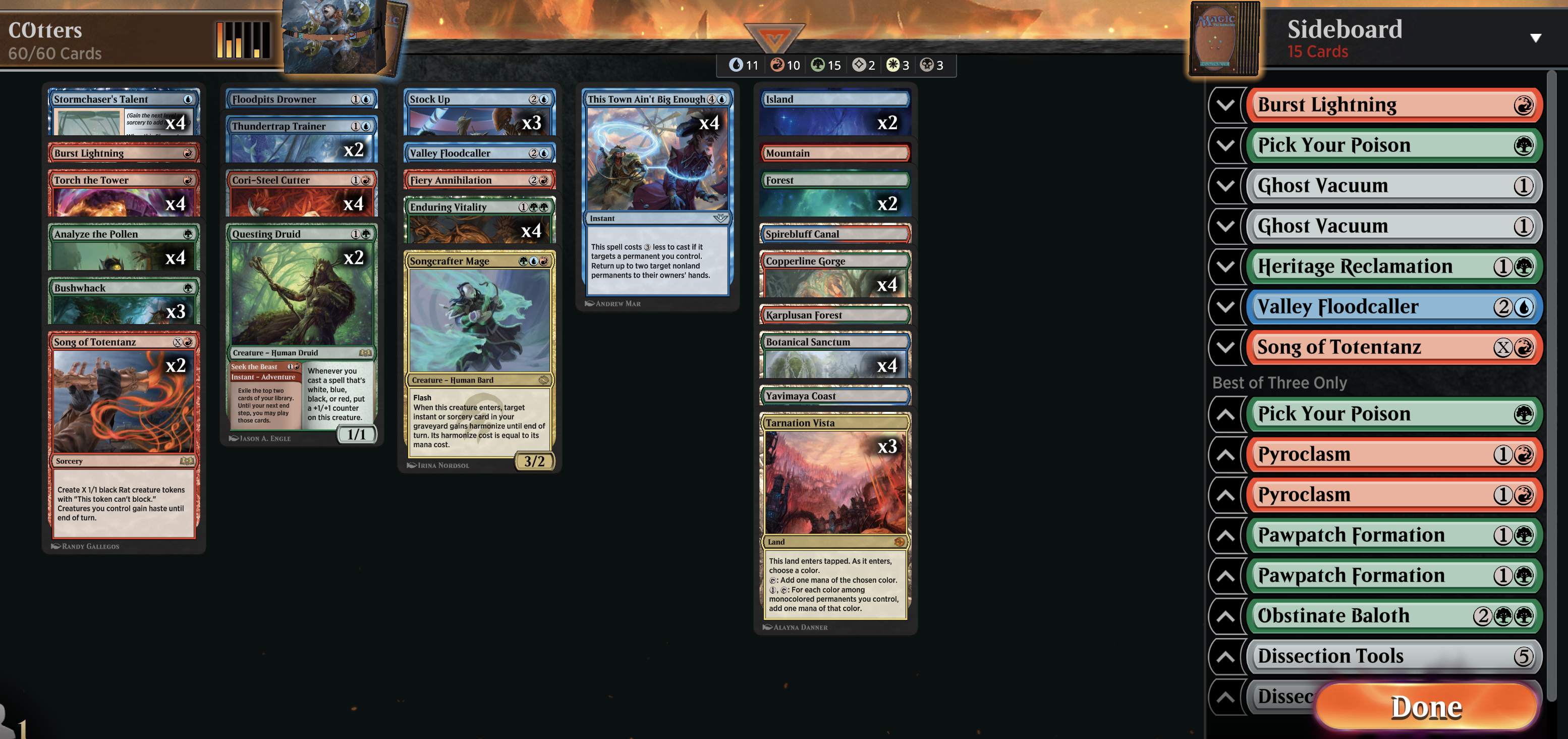
my current otters list
Here's the list I've been playing and would recommend. I'll go over the choices in detail below, but for now am leaving this here as a reference.
Part 1: Incoherent, or Flexible?
The main thing that Cori-Steel Cutter adds to the deck is a second powerful angle. Whereas before, the only rawly powerful things the deck did always involved
Enduring Vitality; now with Cutter the deck can produce strong, threatening draws even without Vitality.With Cutter, sometimes the draws this deck can produce look not unlike those of Izzet Prowess! You have Cutter,
Stormchaser's Talent, and Stock Up; and instead of cantrips, you have land searchers. Of course you're missing some of the most aggressive elements of the prowess deck, but you don't always need Slickshot Show-Off or Monstrous Rage to kill people.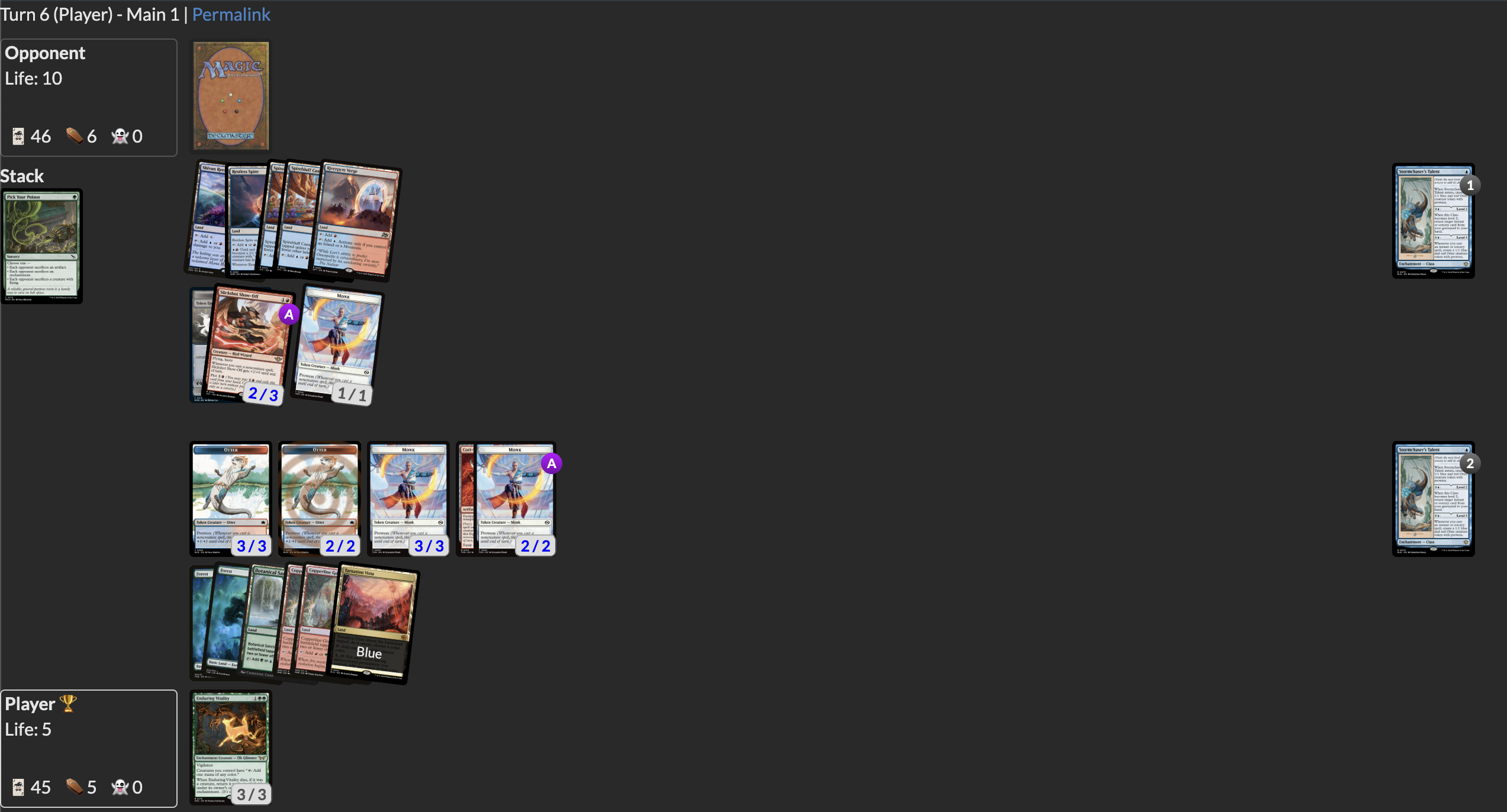
an example of winning the race vs the 'pseudomirror' postboard, killing them on turn 6 while interacting a bunch
Instead, you trade those most aggressive elements for better and more consistent removal, and the ability to be extremely strong in the late game through Vitality.
One might call this deck structure a little bit incoherent - you might ask, how is Vitality contributing to your aggressive Cutter draws, and how is Cutter contributing to your lategame Vitality draws?
And while it is indeed hard for Vitality to help much with your aggressive draws (other than by being a 3 mana 3/3), the same is not true for the opposite - Otters as a deck is very good at double spelling, allowing Cutter to provide a constant flow of tokens which can tap for mana with Vitality even if they aren't attacking.
And digging a little deeper, while the two different gameplans might be distinct, they both benefit off of the same kinds of synergies and cards. Cutter wants you to have a constant stream of spells so that you can double spell every turn; similarly, Vitality wants you to have enough card flow to spend the large amount of mana it gives you. Cutter wants you to pressure your opponent with creatures; Vitality can let those creatures turn into mana if your opponent puts up enough defense to prevent them from attacking.
There's even some neat specific card overlaps that you might not realize at first glance. For example,
Song of Totentanz is a powerful card lets you effectively double your mana for next turn with Vitality out, and setup for a combo kill with Valley Floodcaller; but it also can serve as a powerful aggressive tool when prowess creatures are involved. "R: creatures you control gain haste" is not a spell you would put in your deck just by itself, but having that mode available has won me quite a few games.In summary, this deck is certainly worse than Izzet Prowess at being an aggressive deck, there's no question about that. But being worse does not mean it isn't capable; and the ability to threaten such aggressive draws can be a very nice way to force your opponent to commit resources interacting with it and ignoring your actual lategame; or a nice out to winning a race when you have no way to deal with your opponent's threats. And in exchange for being worse at being aggressive, you get access to a more powerful and consistent lategame; while being significantly harder for other decks to build a gameplan for.
Part 2: New Cards, New Play Patterns
Many people think of Otters as a combo deck, with its primary gameplan being assembling the combo of
Enduring Vitality and Valley Floodcaller. And certainly, this is an important line that the deck will often try to setup to win - but especially with the new direction of the deck, it is not at all the main focus.The Combo
The basic gist of the combo is that Floodcaller untaps all your otters and rats when you cast a noncreature spell, and you can make many otters and rats with
Stormchaser's Talent and especially Song of Totentanz.With Vitality out, this lets you generate mana equal to your hasty otters and rats every time you cast a noncreature spell, which lets you loop
This Town Ain't Big Enough with Stormchaser's Talent as long as you have 3-4 otters/rats, or just cast a few spells and swing with many large creatures buffed by Floodcaller.A common combo line in this deck is to cast Song of Totentanz for X=4 or more to make hasty rats, then
Analyze the Pollen to find Floodcaller, cast Floodcaller, and then start casting chains of noncreature spells. With TTABE and Talent it can be infinite; but often This combo is powerful because it can come out of nowhere, as Song gives the rats haste. Everything can be played out from hand in one turn, though usually you start with Vitality in play.Instead, I would describe this deck as a critical mass deck. Often, your goal in a given turn is to simply increase the number of resources you have access to the next turn by as much as possible, until your mana advantage overwhelms your opponent. The Floodcaller combo is the ultimate culmination of this process of accruing resources, but it isn't always necessary. The important part is simply leveraging Enduring Vitality to develop your mana, while making sure you never run out of things to do with Stormchaser's Talent and
Stock Up.As a demonstration of this fact, I strongly believe that the deck wants to play exactly one copy of Floodcaller maindeck. It's important to have one copy to be able to produce combo lines with Analyze, but you would generally rather not draw it naturally. For the matchups where you do want more access to the combo, we can just play a second copy in the sideboard.
Cutting Between Roles
That said, as mentioned above there are now some quite strong aggressive lines available to the deck with Cutter. It's now more important than ever to sequence your spells correctly with this in mind. When you start with Cutter in your hand, you should often ask yourself how you plan on maximizing your cutter triggers - this can often involve not playing a spell that you could play on turn 1.
In fact, when you draw both Cutter and Vitality, I find myself more often than not choosing to prioritize triggering Cutter more than developing Vitality. Playing a Vitality on turn 3 is usually not a great followup to a turn 2 Cutter, so I've been finding myself delaying Vitality until turn 4 or 5, when I have more of a board to take advantage of it.
And this gets at another reason you might want to make this play - specifically, the role of Cutter transitions quite interestingly throughout the various stages of the game.
When you play Cutter on turn 2, one of the things it's best at is attacking. Blocking with prowess creatures can be difficult - though we do have many instant speed spells to help with it if necessary. But the early turns of Otters tend to involve a bunch of sorcery-speed setup spells anyways: things like casting a land-searcher, or developing creatures with Talent.
Sometimes, this leads to you having a good enough aggressive early start to fully get there; be on the lookout for when this might be the case. If you cast Talent on turn 1, Cutter on turn 2, then two noncreature spells on turn 3, then you're already able to attack for 7 total - it's not that hard to close out that last 13.
While it's good to get this early aggression, you won't always be able to close. But that's fine, as you can pretty easily transition even those aggressive draws into a coherent midgame value plan - because those monk tokens that were attacking your opponent can tap for mana once you play Vitality! Midgames involving both Vitality and Cutter often involve mostly using Cutter to build up your mana. It's really easy to make one monk per turn cycle, and not even that difficult to make two, one on each turn!
In these midgames, one of your most important tasks is to not run out of card flow. Thankfully, there are a lot of ways to keep seeing new cards - between Analyze finding
Thundertrap Trainer or Questing Druid, and Talent getting back spells, there's plenty of modality in all of your cards. But as a critical mass deck, it's important to make sure your plays are always chaining into more resources. Sometimes you might need to cut of some resources in order to answer threats (for example, taking more removal spells off of Stock Up, rather than a second Stock Up) - but when in doubt, generally go for the line that increases your resources the most.Then, endgames just involve leveraging this advantage and engine to either produce a Floodcaller combo with Analyze, or kill your opponent with prowess-y Cutter monks. Which one you go with doesn't matter that much - but at some point you should end the game.
Of course, things aren't always quite this clean. There will be plenty of scrappy games, and sometimes you won't draw Vitality. Thankfully, those games are the ones where Cutter tends to shine - be sure to recognize when you aren't able to put together a Vitality engine, and instead need to focus on killing your opponent with Cutter.
Plus, we now have access to a different non-Vitality card that can serve as a mana engine...
What in Tarnation?

Tarnation Vista
Tarnation Vista has been a card that Otters has played since the beginning, but usually only one copy. Two of the cards you are most looking to cast in Otters - Enduring Vitality and Stormchaser's Talent - fill out blue and green monocolor permanents, and also have the nice properties of sticking on the board fairly well. In the past we played one copy of Vista to go with some of the permanent-based red removal spells - but now we have a much stronger option: Cori-Steel Cutter.
Not only is Cutter a red permanent; it also makes white monks! And both of these colors of permanents are also fairly sticky, as it's not that easy to remove Cutter itself, and as long as Cutter is on the board you can make a new monk just by casting two spells.
So now, a board with just Vitality, Talent, and Cutter can let a Tarnation Vista tap for 3 mana (WURG, minus the 1 mana you need to spend to activate it). With a black rat from Song of Totentanz, you can even get up to 4! And even without all three, Cutter plus either of the others gives you a sol land that taps for 2.
With the inclusion of 4 Cutters in Otters, Tarnation Vista has become valuable enough to play multiple copies. I'm currently playing 3, as I think I would like to draw my first Vista but don't care about drawing my second.
Crafting Songs of Totentanz

Songcrafter Mage
The name of
Songcrafter Mage is quite fitting in this deck, as one of its main use-cases is harmonizing with Song of Totentanz itself. Harmonize lets you pay for a bigger X by tapping a large creature - for example tapping the Songcrafter itself gets you three more rats.But overall it's just a fairly flexible card. Harmonizing a removal spells is fine, harmonizing a Town lets it reset itself, and harmonizing a Stock Up just gives you more way to chain action into action. It's definitely less valuable than any of the other Analyze tutor targets, but I think it's still good enough to include a copy, specifically because of the interaction with Song.
WARNING: If you're playing on Arena, beware that there is, at time of writing (4/27), a bug with Songcrafter. If you target Torch the Tower or Analyze the Pollen with Songcrafter, you are forced to bargain or collect evidence, respectively. You can always choose not to cast the spell, but you cannot currently harmonize an unbargained Torch or an uncollected analyze, even though you should be able to.
Part 3: Matchups and Sideboarding
As usual with my sideboard guides, here's a spreadsheet with my mapping.

and just for reference, the list one more time
This build of the deck is actually quite tight. To give an idea of just how tight, the only slots I really consider flexslots in the maindeck are the second Thundertrap, the Burst Lightning, the Songcrafter, and the Fiery Annihilation.
Everything else is quite necessary:
- the manabase is fairly optimized
- the land searchers are important for Cutter- and Vitality-related structural reasons
- the Vitalities and Cutters obviously need to be 4-ofs as the cards the deck is built around
- the Talents are necessary to enable and payoff big mana with Vitality
- the Torches and TTABEs are just the best interaction suite the deck can play
- the 2 Druid / 3 Stock Up split is close to the minimum amount of card draw the deck needs, and definitely needs to be split that way for Analyze reasons
- the Songs and Floodcaller maindeck are necessary to have some combo threat
- at least one Thundertrap is necessary as a midgame grindy Analyze target
- the Floodpits Drowner is an important Analyze target as Analyzable removal
Izzet Prowess
In (7): 2 Dissection Tools, 2 Pick Your Poison, 2 Pyroclasm, 1 Burst Lightning
Out (7): 1 Trainer, 1 Stock Up, 1 Floodcaller, 2 Song, 1 Annihilation, 1 Songcrafter
This matchup is one where you don't really want to be trying to Floodcaller combo at all. You don't have enough time to set it up, and drawing a dead card like either Floodcaller or Song can be very bad when you don't have the combo.
Instead, postboard you want to try to race with Cutter, control their board with PYP and Pyroclasm, and/or stabilize with Dissection Tools.
Mice
In (4): 2 Dissection Tools, 1 Pyroclasm, 1 Burst Lightning
Out (4): 1 Trainer, 1 Floodcaller, 2 Song
This category is a standin for all red decks playing the mice package of
Manifold Mouse, Heartfire Hero, and Emberheart Challenger. That said, there are many different versions of the deck, from Mono-Red to Gruul to Cutter versions. so use your best judgment for how to alter this plan - for instance, maybe bring in more Pyroclasms depending on how many 1s or Cutters they have.That said, the plan is largely the same as vs the Prowess decks, except you don't bring in the anti-Cutter cards.
Overall, I'd say that all of these red aggro decks are fairly even matchups, and a lot of the exact percentages come down to the aggro build. Prowess can put on burst damage and play late into the game with Stock Up, but doesn't have the scariest card in
Screaming Nemesis.Esper Pixie
In (?): 1 Pyroclasm, 1 Obstinate Baloth, maybe more
Out (?): 1 Floodpits Drwoner, maybe more
Pixie is a weird one because there are so many different builds of it, and how you want to sideboard depends a lot on their build
As a rule of thumb, you shouldn't be siding out Cutters, Vitalities, Talents, Stock Ups, or Druids. I also like keeping in 2 Song 1 Floodcaller because Song can sometimes just be good vs them.
If they have cards like Entity Tracker or Sheoldred, Fiery Annihilation should be kept in; otherwise cut it.
If they have Lockdowns in the sideboard, you should bring in Pawpatch Formations (but not Heritage Reclamation or Pick Your Poison) to deal with them.
Pyroclasm is good to have a copy of to fight otter-ful draws on their side; if they're playing a more aggressive build with cards like
Spiteful Hexmage, you can consider bringing in a second.Trimming one TTABE can be fine, as they don't have much you want to bounce. You can cut a land on the draw, you can trim a Song if you feel like it, the Songcrafter isn't necessary.
Basically, there's a lot of vibes involved. But the matchup is I think baseline a bit favored for us with Cutter now, which is nice.
Omniscience Combo
In (7): 1 Valley Floodcaller, 1 Song of Totentanz, 2 Ghost Vacuum, 1 Heritage Reclamation, 2 Pawpatch Formation
Out (7): 2 Cori-Steel Cutter, 2 Torch the Tower, 1 Burst Lightning, 1 Fiery Annihilation, 1 Floodpits Drowner
This matchup is a scary one, but also one that I believe should be quite favored if played well. Game 1 is unfavored, but the postboard graveyard hate and extra combo cards help a lot.
Your goal in this matchup should be to hold up interaction every turn they threaten to combo, until you combo yourself. They are very bad at stopping your combo, or removing Vitality from the board at all, so this isn't that difficult.
Unfortunately, Cutter is not very good here, as you aren't quite good enough at leveraging it to aggro, and often don't want to cast two spells on your turn rather than holding up mana. In hands without Vacuum, you should be mulliganing quite a lot to find Vitality, both to combo and just to have more mana to be able to hold up productively.
Torch isn't amazing, but you want a couple for killing small Omnis or Grand Abolishers; Pawpatch comes in specfically for Lockdown (or as a mediocre removal spell for a reanimated Omni).
Jeskai Oculus
In (7): 1 Valley Floodcaller, 1 Song of Totentanz, 2 Ghost Vacuum, 1 Heritage Reclamation, 2 Pawpatch Formation
Out (7): 1 Bushwhack, 1 Thundertrap Trainer, 2 Cori-Steel Cutter, 2 Torch the Tower, 1 Burst Lightning
Cutter isn't always bad in this matchup, but it does get invalidated quickly by their best draws. On top of that, they aren't very good at dealing with the Floodcaller combo; as such, postboard it's good to focus on that.
In general you just want to play a controlling game against Oculus, killing their important threats (which sometimes might be
Proft's Eidetic Memory!) and building your own resources. Overall I think it's quite a close matchup, and a lot of games come down to whether the Oculus player draws well or doesn't (which is fairly typical of their deck, with all of its inconsistencies).Wx Control
In (6): 1 Valley Floodcaller, 1 Song of Totentanz, 2 Pawpatch Formation, 2 Pick Your Poison
Out (6): 1 Cori-Steel Cutter, 2 Torch the Tower, 1 Burst Lightning, 1 Fiery Annihilation, 1 Floodpits Drowner
This is another broad category of matchups, including everything from Jeskai Control to UW Control to Caretaker's. While the cards may change from one of these matchups to another, fundamentally they work the same: disenchants and/or plummets are good vs them (to kill Lockdown, High Noon, and big fliers), you need to play around wraths, and the Floodcaller combo is quite good.
These matchups are also the epitome of accruing resources, as you just have so much time to do so. As long as you keep playing cards that force your opponent to interact while still chaining into more cards, and occasionally answering your opponent's card draw engines, it's pretty easy to win here. Kicking Trainer happens extremely often.
Domain
In (7): 1 Valley Floodcaller, 1 Song of Totentanz, 1 Heritage Reclamation, 2 Pawpatch Formation, 2 Pick Your Poison
Out (7): 1 Cori-Steel Cutter, 3 Torch the Tower, 1 Burst Lightning, 1 Fiery Annihilation, 1 Floodpits Drowner
Domain is secretly just another form of Wx control, except I felt a little weird calling it that. The in-game prioritization is a bit different - namely, naturalizes are much more of a focus - but the mapping itself is very similar.
UB Midrange
In (1): 1 Pyroclasm
Out (1): 1 Floodpits Drowner
I honestly am a little surprised people still play this deck, but it's certainly good for Otters. Pyroclasm is good against their random small fliers, and not much else has to change at all.
Orzhov Pixie
In (6): 1 Valley Floodcaller, 1 Song of Totentanz, 1 Heritage Reclamation, 2 Pawpatch Formation, 1 Obstinate Baloth
Out (6): 1 Tarnation Vista, 2 Cori-Steel Cutter, 1 Burst Lightning, 1 Fiery Annihilation, 1 Floodpits Drowner
This matchup roughly goes as follows: if they assemble a Lockdown loop with a Hopeless Nightmare, they are favored. If not, it's really hard for them to win (though they can get there with the normal Pixie Nightmare beats, they're just much worse at keeping up in the late game).
As such, you really want to focus on keeping them off of Lockdown and Nightmare, and the combo becomes much more consistent at accomplishing things than Cutter, as you don't need to play into Lockdown.
There are some other various matchups you could think about, but they aren't that popular and I haven't played them that much, so I won't go into further detail here. In general, the important things to think about are how relevant you think Cutter is, and how good the Floodcaller combo is. Longer games where Cutter can be interacted with favor Floodcaller combo; shorter games favor Cutter.
Conclusion
I'm not sure exactly how much I would recommend picking up this deck before RC Minneapolis, if you haven't already tried it. It's a very complex deck, and there isn't all that much time to learn it or find cards.
But if you already are familiar with the deck from having played it previously, I would highly recommend trying out this new build of Otters. And I would especially recommend considering this deck for any later tournaments, like Hartford. I think it's quite well positioned into the meta, with the worst matchups mostly still being pretty even coinflips, and has the classic Otters benefit of being hard to target or sideboard against.
I'll probably have a little more to say after Minneapolis next week; I'll probably post another update then!
UPDATE: I have written an addendum/tournament report here.
#FreePalestine | Consider donating to UNWRA or PCRF, supporting protesters locally, and educating yourself.
